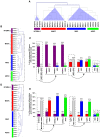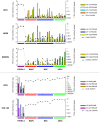Epigenetic signatures associated with different levels of differentiation potential in human stem cells
- PMID: 19915669
- PMCID: PMC2771914
- DOI: 10.1371/journal.pone.0007809
Epigenetic signatures associated with different levels of differentiation potential in human stem cells
Abstract
Background: The therapeutic use of multipotent stem cells depends on their differentiation potential, which has been shown to be variable for different populations. These differences are likely to be the result of key changes in their epigenetic profiles.
Methodology/principal findings: to address this issue, we have investigated the levels of epigenetic regulation in well characterized populations of pluripotent embryonic stem cells (ESC) and multipotent adult stem cells (ASC) at the trancriptome, methylome, histone modification and microRNA levels. Differences in gene expression profiles allowed classification of stem cells into three separate populations including ESC, multipotent adult progenitor cells (MAPC) and mesenchymal stromal cells (MSC). The analysis of the PcG repressive marks, histone modifications and gene promoter methylation of differentiation and pluripotency genes demonstrated that stem cell populations with a wider differentiation potential (ESC and MAPC) showed stronger representation of epigenetic repressive marks in differentiation genes and that this epigenetic signature was progressively lost with restriction of stem cell potential. Our analysis of microRNA established specific microRNA signatures suggesting specific microRNAs involved in regulation of pluripotent and differentiation genes.
Conclusions/significance: Our study leads us to propose a model where the level of epigenetic regulation, as a combination of DNA methylation and histone modification marks, at differentiation genes defines degrees of differentiation potential from progenitor and multipotent stem cells to pluripotent stem cells.
Conflict of interest statement
Figures







Similar articles
-
Profiling of DNA and histone methylation reveals epigenetic-based regulation of gene expression during retinal differentiation of stem/progenitor cells isolated from the ciliary pigment epithelium of human cadaveric eyes.Brain Res. 2016 Nov 15;1651:1-10. doi: 10.1016/j.brainres.2016.09.001. Epub 2016 Sep 15. Brain Res. 2016. PMID: 27641993
-
Cryosectioning the intestinal crypt-villus axis: an ex vivo method to study the dynamics of epigenetic modifications from stem cells to differentiated cells.Stem Cell Res. 2015 Jan;14(1):105-13. doi: 10.1016/j.scr.2014.12.002. Epub 2014 Dec 27. Stem Cell Res. 2015. PMID: 25590428
-
Epigenetic Signatures at the RUNX2-P1 and Sp7 Gene Promoters Control Osteogenic Lineage Commitment of Umbilical Cord-Derived Mesenchymal Stem Cells.J Cell Physiol. 2017 Sep;232(9):2519-2527. doi: 10.1002/jcp.25627. Epub 2017 Mar 28. J Cell Physiol. 2017. PMID: 27689934
-
Epigenetic states in stem cells.Biochim Biophys Acta. 2009 Sep;1790(9):900-5. doi: 10.1016/j.bbagen.2008.10.006. Epub 2008 Oct 25. Biochim Biophys Acta. 2009. PMID: 19013220 Review.
-
Epigenetics in embryonic stem cells: regulation of pluripotency and differentiation.Cell Tissue Res. 2008 Jan;331(1):23-9. doi: 10.1007/s00441-007-0536-x. Epub 2007 Nov 15. Cell Tissue Res. 2008. PMID: 18004593 Review.
Cited by
-
Application of MultiStem(®) Allogeneic Cells for Immunomodulatory Therapy: Clinical Progress and Pre-Clinical Challenges in Prophylaxis for Graft Versus Host Disease.Front Immunol. 2012 Nov 27;3:345. doi: 10.3389/fimmu.2012.00345. eCollection 2012. Front Immunol. 2012. PMID: 23205020 Free PMC article.
-
Human embryonic stem cell responses to ionizing radiation exposures: current state of knowledge and future challenges.Stem Cells Int. 2012;2012:579104. doi: 10.1155/2012/579104. Epub 2012 Aug 16. Stem Cells Int. 2012. PMID: 22966236 Free PMC article.
-
Thymidine phosphorylase exerts complex effects on bone resorption and formation in myeloma.Sci Transl Med. 2016 Aug 24;8(353):353ra113. doi: 10.1126/scitranslmed.aad8949. Sci Transl Med. 2016. PMID: 27559096 Free PMC article.
-
Oriented immobilization of basic fibroblast growth factor: Bioengineered surface design for the expansion of human mesenchymal stromal cells.Sci Rep. 2020 May 29;10(1):8762. doi: 10.1038/s41598-020-65572-2. Sci Rep. 2020. PMID: 32472000 Free PMC article.
-
Human cardiomyogenesis and the need for systems biology analysis.Wiley Interdiscip Rev Syst Biol Med. 2011 Nov-Dec;3(6):666-80. doi: 10.1002/wsbm.141. Epub 2010 Dec 31. Wiley Interdiscip Rev Syst Biol Med. 2011. PMID: 21197666 Free PMC article. Review.
References
-
- Hoffman LM, Carpenter MK. Characterization and culture of human embryonic stem cells. Nat Biotechnol. 2005;23:699–708. - PubMed
-
- Bibikova M, Laurent LC, Ren B, Loring JF, Fan JB. Unraveling epigenetic regulation in embryonic stem cells. Cell Stem Cell. 2008;2:123–134. - PubMed
-
- Bernstein BE, Mikkelsen TS, Xie X, Kamal M, Huebert DJ, et al. A bivalent chromatin structure marks key developmental genes in embryonic stem cells. Cell. 2006;125:315–326. - PubMed
-
- Pan G, Tian S, Nie J, Yang C, Ruotti V, et al. Whole-genome analysis of histone H3 lysine 4 and lysine 27 methylation in human embryonic stem cells. Cell Stem Cell. 2007;1:299–312. - PubMed
Publication types
MeSH terms
Substances
LinkOut - more resources
Full Text Sources
Other Literature Sources
Medical
Miscellaneous

